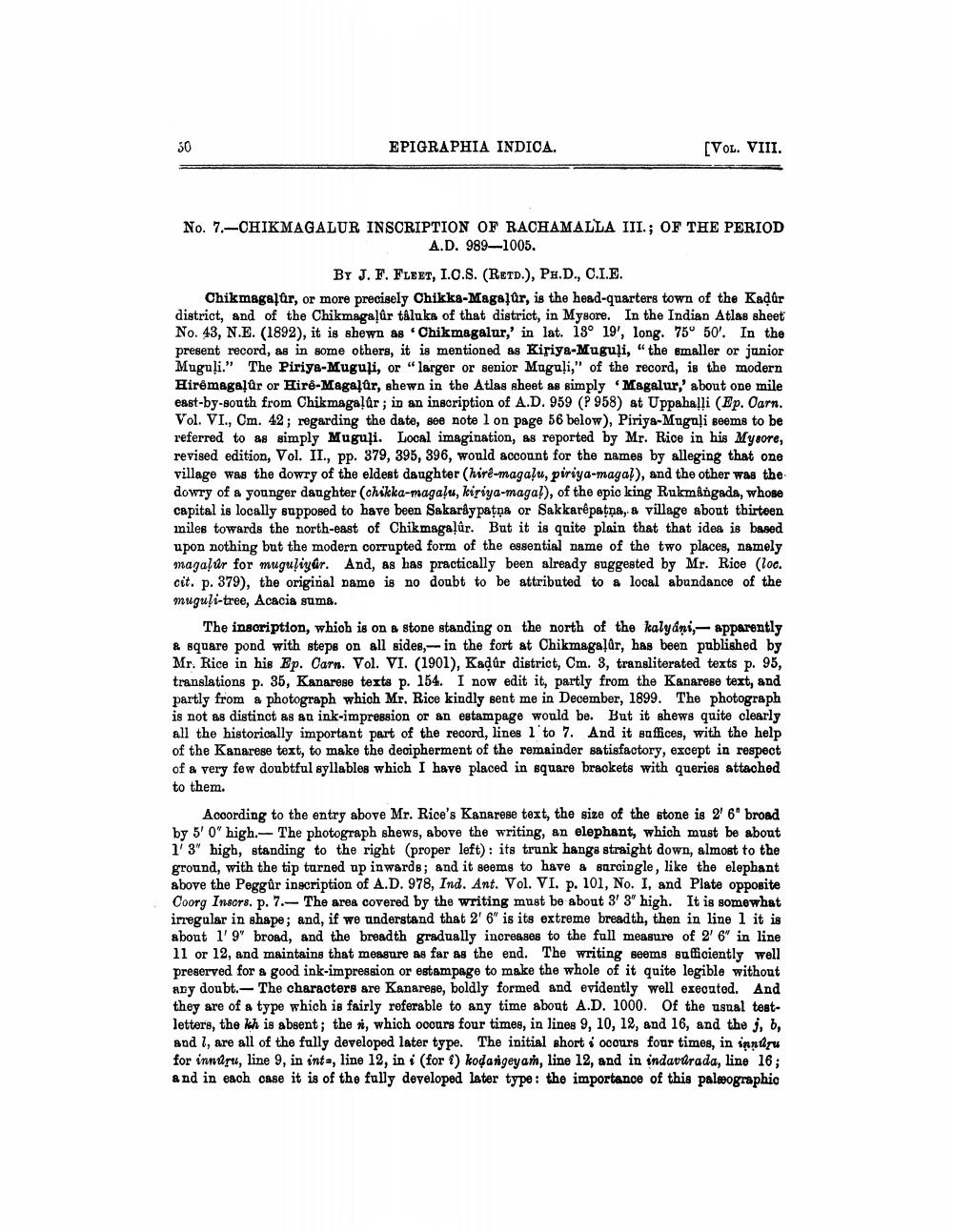________________
EPIGRAPHIA INDICA.
[VOL. VIII.
No. 7.-CHIKMAGALUR INSCRIPTION OF RACHAMALLA III.; OF THE PERIOD
A.D. 989-1005.
BY J. F. FLEET, I.C.S. (Retd.), PH.D., C.I.E. Chikmagalur, or more precisely Chikka-Magasûr, is the head-quarters town of the Kadur district, and of the Chikmagalur taluks of that district, in Mysore. In the Indian Atlas sheet No. 43, N.E. (1892), it is shewn as Chikmagalur,' in lat. 13° 19', long. 75° 50'. In the present record, as in some others, it is mentioned as Kiriya-Muguli," the smaller or junior Muguli." The Piriya-Muguli, or "larger or senior Magali," of the record, is the modern Hirêmagaļür or Hire-Magalar, shewn in the Atlas sheet as simply Magalur,' about one mile east-by-south from Chikmagalur; in an inscription of A.D. 959 (P 958) at Uppahalli (Ep. Oarn. Vol. VI., Cm. 42; regarding the date, see note l on page 56 below), Piriya-Mugaļi seems to be referred to as simply Muguļi. Local imagination, as reported by Mr. Rice in his Mysore, revised edition, Vol. II, pp. 879, 395, 396, would account for the names by alleging that one village was the dowry of the eldest daughter (hirê-magalu, piriya-magal), and the other was the dowry of a younger daughter (chakka-magalu, kiriya-magal), of the epic king Rukmangada, whose capital is locally supposed to have been Sakardypatna or Sakkarêpatņa, a village about thirteen miles towards the north-east of Chikmagalûr. But it is quite plain that that idea is based upon nothing but the modern corrupted form of the essential name of the two places, namely magaļúr for muguliyür. And, as has practically been already suggested by Mr. Rice (loc. cit. p. 379), the original name is no doubt to be attributed to a local abundance of the muguļi-tree, Acacia suma.
The insoription, which is on a stone standing on the north of the kalyani, apparently & square pond with steps on all sides, in the fort at Chikmagalur, has been published by Mr. Rice in his Ep. Carn. Vol. VI. (1901), Kadür district, Cm. 3, transliterated texts p. 95, translations p. 35, Kanarege texts p. 154. I now edit it, partly from the Kanarese text, and partly from a photograph which Mr. Rice kindly sent me in December, 1899. The photograph is not as distinct as an ink-impression or an estampage would be. But it shews quite clearly all the historically important part of the record, lines 1 to 7. And it soffices, with the help of the Kanarese text, to make the decipherment of the remainder satisfactory, except in respect of & very few doubtful syllables which I have placed in square brackets with queries attached to them.
A coording to the entry above Mr. Rice's Kanarese text, the size of the stone is 2' 6" broad by 5'0' high. - The photograph shews, above the writing, an elephant, which must be about 1'3" high, standing to the right (proper left): its trunk hangs straight down, almost to the ground, with the tip tarned op inwards; and it seems to have & sarcingle, like the elephant above the Peggûr inscription of A.D. 978, Ind. Ant. Vol. VI. p. 101, No. I, and Plate opposite Coorg Insors, p. 7.--The area covered by the writing must be about 3' 3" high. It is somewhat irregular in shape; and, if we understand that 2' 6" is its extreme breadth, then in line 1 it is about 1'9' broad, and the breadth gradually increases to the full measure of 2' 6' in line 11 or 12, and maintains that measure as far as the end. The writing seems sufficiently well preserved for a good ink-impression or estampage to make the whole of it quite legible without any doubt.- The characters are Kanarese, boldly formed and evidently well executed. And they are of a type which is fairly referable to any time about A.D. 1000. Of the usual testletters, the kin is absent; then, which ooours four times, in lines 9, 10, 12, and 16, and the j, b, and 1, are all of the fully developed later type. The initial short i cours four times, in innugu for innúru, line 9, in inta, line 12, in i (for) kodanigeyan, line 12, and in indavúrada, line 16; and in each case it is of the fully developed later type: the importance of this paleographic




